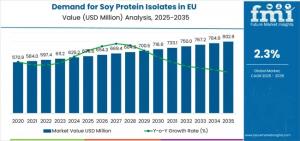EU Soy Protein Isolate Market to Reach USD 802.9 Million by 2035 — Functional Foods Drive Moderate Growth Across Europe
EU soy protein isolate market grows steadily through 2035, led by functional foods and clean-label trends, driven by sustainable protein adoption.
NEWARK, DE, UNITED STATES, November 13, 2025 /EINPresswire.com/ -- The EU soy protein isolate market is projected to expand from USD 639.6 million in 2025 to USD 802.9 million by 2035, registering a CAGR of 2.3%. Growth is supported by increasing adoption of plant-based proteins, advancements in isolation technologies, and expanding use across functional foods, beverages, and nutritional applications.
To Explore Detailed Market Data, Segment-Wise Forecasts, and Competitive Insights, Request Sample Report! https://www.futuremarketinsights.com/reports/sample/rep-gb-27202
Market Overview
The dry soy protein isolate (SPI) format will continue to dominate with an 82.0% share in 2025, equivalent to USD 524.5 million, due to its superior stability and versatility. Functional foods remain the largest application segment, accounting for 38.0% of total value (USD 243.0 million) in 2025.
Between 2025 and 2030, the market is projected to add USD 87.6 million in value as consumer preference for clean-label, high-protein, and sustainable foods strengthens across Europe. From 2030 to 2035, soy protein isolates will gain wider acceptance in sports and clinical nutrition applications, creating consistent, long-term growth momentum.
Demand Drivers and Market Dynamics
Key factors supporting growth include:
• Rising consumer preference for plant-based and clean-label proteins.
• Technological innovations in isolation and purification improving flavor, solubility, and performance.
• Expansion of functional foods, nutritional supplements, and meat alternatives.
• Increasing emphasis on sustainability, non-GMO sourcing, and European production traceability.
Soy protein isolates continue to benefit from their complete amino acid profile, superior functionality, and ability to align with EU climate and sustainability objectives. Health-conscious consumers and manufacturers alike are turning to soy isolates to meet nutritional goals while reducing environmental impact.
Product and Application Insights
By Product Type:
The dry SPI segment will retain an 82.0% market share in 2025, expected to slightly decline to 80.4% by 2035 as liquid formulations gain traction. Its dominance is supported by long shelf life, ease of transport, and high functionality across protein bars, bakery items, and nutritional beverages.
By Application:
Functional foods account for 38.0% of total market value in 2025, projected to rise to 39.8% by 2035. The segment benefits from the strong integration of soy isolates in energy bars, shakes, fortified snacks, and plant-based cereals, driven by sports nutrition and wellness trends.
Regional Outlook
• Germany remains the largest market, expected to grow from USD 172.7 million in 2025 to USD 221.8 million by 2035 (2.4% CAGR), supported by robust infrastructure and mature plant-based adoption.
• France follows with a 2.5% CAGR, driven by the expanding functional food and clinical nutrition sectors.
• The Netherlands matches this pace with 2.5% CAGR, emerging as a hub for soy protein innovation.
• Spain and Italy grow steadily at 2.3% and 2.1% CAGR, respectively, reflecting mainstreaming of plant-based alternatives and fortified food trends.
• The Rest of Europe segment grows at 1.8% CAGR, indicating gradual adoption across emerging and Eastern European markets.
Technological and Sustainability Trends
1. Isolation Technology Advancements:
Enhanced membrane filtration, enzymatic processing, and pH-shifting are improving flavor neutrality, solubility, and functional consistency, allowing soy isolates to perform comparably to animal proteins in diverse formulations.
2. Sustainability Integration:
Producers are embedding sustainability credentials — including reduced carbon footprint and energy efficiency — into their brand positioning, resonating with Europe’s eco-conscious consumers and policymakers.
3. Non-GMO and Regional Sourcing:
Rising demand for non-GMO and Europe-grown soy isolates reflects the growing importance of transparency, traceability, and local sourcing across the supply chain.
Subscribe for Year-Round Insights → Stay ahead with quarterly and annual data updates - https://www.futuremarketinsights.com/checkout/27202
Competitive Landscape
The EU soy protein isolate market remains moderately consolidated, with major players including:
ADM, Cargill, IFF/DuPont, Kerry Group, Fuji Oil, Roquette Frères, Glanbia Nutritionals, Sonic Biochem, and CHS Inc.
• ADM leads with ~16% market share, leveraging global sourcing and deep application expertise.
• Cargill follows with ~11%, focusing on reliable, functional protein ingredients for meat and dairy alternatives.
• IFF/DuPont and Kerry Group specialize in premium and customized isolates targeting high-value nutrition sectors.
Smaller regional processors, collectively holding over 50% of market share, focus on non-GMO certification, organic isolates, and localized production strategies to meet growing demand.
Browse Related Insights
Soy Protein Isolate Market: https://www.futuremarketinsights.com/reports/soy-protein-isolate-market
Soy Lecithin Market: https://www.futuremarketinsights.com/reports/soy-lecithin-market
Why FMI: https://www.futuremarketinsights.com/why-fmi
About Future Market Insights (FMI)
Future Market Insights, Inc. (FMI) is an ESOMAR-certified, ISO 9001:2015 market research and consulting organization trusted by Fortune 500 clients and global enterprises. With operations in the U.S., UK, India, and Dubai, FMI provides data-backed insights and strategic intelligence across 30+ industries and 1,200 markets worldwide.
Sudip Saha
Future Market Insights Inc.
+1 347-918-3531
email us here
Legal Disclaimer:
EIN Presswire provides this news content "as is" without warranty of any kind. We do not accept any responsibility or liability for the accuracy, content, images, videos, licenses, completeness, legality, or reliability of the information contained in this article. If you have any complaints or copyright issues related to this article, kindly contact the author above.

